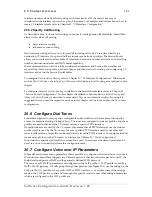
CS Context Overview
181
Software Configuration Guide, Revision 1.03
Interface names can be any arbitrary string with a maximum of 25 characters. For ease of
identification the interface type can be a part of the name. For examples and information on how to
create CS interfaces please refer to Chapter 21, “CS Interface Configuration”
.
20.5.2 Specify Call Routing
As described above, for basic call routing you can omit creating Session Router tables. SmartWare
offers two levels of call routing:
•
basic interface routing
•
advanced session routing
Basic interface routing allows you to forward all incoming calls on a CS interface directly to a
destination CS interface. An optional fallback interface can also be specified. The SessionRouter
allows you to route calls to all available CS interfaces, based on a number of criteria such as calling
number, destination number and ISDN bearer capability.
We recommend that you first carefully consider what interfaces and Session Router tables are
required to achieve your goals on a sheet of paper and then start with creating and configuring CS
interfaces and set up the Session Router tables.
To configure
Basic Interface Routing
refer to Chapter 21, “CS Interface Configuration”. Other topics
such as
Digit Collection
or
Specifing Port Address
es, which belong to call routing are explained in this
chapter.
To configure
Advanced Session Routing
in relation to the Session Router tables refer to Chapter 22,
“Session Router Configuration”. In this chapter the difference between
Basic Interface Routing
and
Advanced Session Routing
is described in more detail. If you are not familiar with call routing it is
suggested that you read the respective sections in this chapter first, before you plan the CS context
configuration.
20.6 Configure Dial Tones
SmartWare supports country-specific configurable in-band dial tones that are played for specific
events, for example alerting, dialing or busy. The tones are configured in tone-set profiles, and these
profiles are used either from the CS context or from a specific PSTN interface.
Nomally tone-sets are used by the CS context, this means that all PSTN interfaces use the tone-set
profile which is used by the CS context. In case a specific PSTN interface needs to use other dial
tones, a different tone-set profile can be used directly from the PSTN interface. To configure the dial
tones and apply then to the CS context or interface see Chapter 23, “Tone Configuration”.
If no tone-set is specified a default tone-set profile is used. In most cases the default profile can be
used, so you do not need to perform this configuration task.
20.7 Configure Voice over IP Parameters
In SmartWare there are many parameters that is possible to configure which can affect a voice over
IP connection. SmartWare supports two different protocols that transmit voice packets over IP, the
Inalp developed protocol ISoIP and the generally defined H.323 protocol.
The voice over IP (VoIP) parameters are configured in the VoIP profile. A VoIP profile is used by a
ISoIP or H.323 gateway. All calls going through that gateway (see Figure 20-3) use the settings in the
VoIP profile. It is possible, for a specific ISoIP or H.323 interface, to overwrite some of the settings
made in the VoIP profile, so that a call through this specific interface uses other settings. Parameters
which are configured in the VoIP profile are:
Summary of Contents for SmartWare R2.00
Page 2: ......
















































